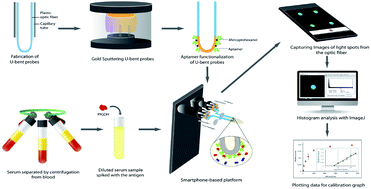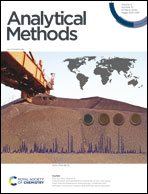A smartphone-based fiber-optic aptasensor for label-free detection of Plasmodium falciparum glutamate dehydrogenase†
Abstract
A novel smartphone-based, multi-channel, optic fiber platform for quantitative detection of Plasmodium falciparum glutamate dehydrogenase (PfGDH) has been explored in this study. A four-channel smartphone slip-on accessory was fabricated to couple one end of the optic fibers to the smartphone flashlight and the other end to the smartphone camera. The optic fiber probes for this setup were prepared with gold-sputtered U-bent plastic optic fibers and functionalized with an aptamer specific for PfGDH. The images of the light spots from the fiber were captured from this setup at specific time intervals after incubation with simulated malaria samples. The blue histogram values (B-value) of the light spots in the captured images were obtained using ImageJ software. The sensor statistically exhibited a limit of detection (LOD) of 264 pM and utilized only 175 μL of the sample. The specificity of this system was evaluated by exposing it to interferents like human glutamate dehydrogenase (HGDH), Plasmodium lactate dehydrogenase (PfLDH), and Plasmodium falciparum Histidine Rich Protein-II (PfHRP-II) and the response to these interferents was found to be very minimal when compared to the response to the aptamer–PfGDH interaction. A shelf-life study was also performed, with probes maintained at room temperature (25–30 °C) with relative humidity in the range of 70–90%. The efficiency of the probes on the 20th day was found to be 91.38% of the initial output.



 Please wait while we load your content...
Please wait while we load your content...